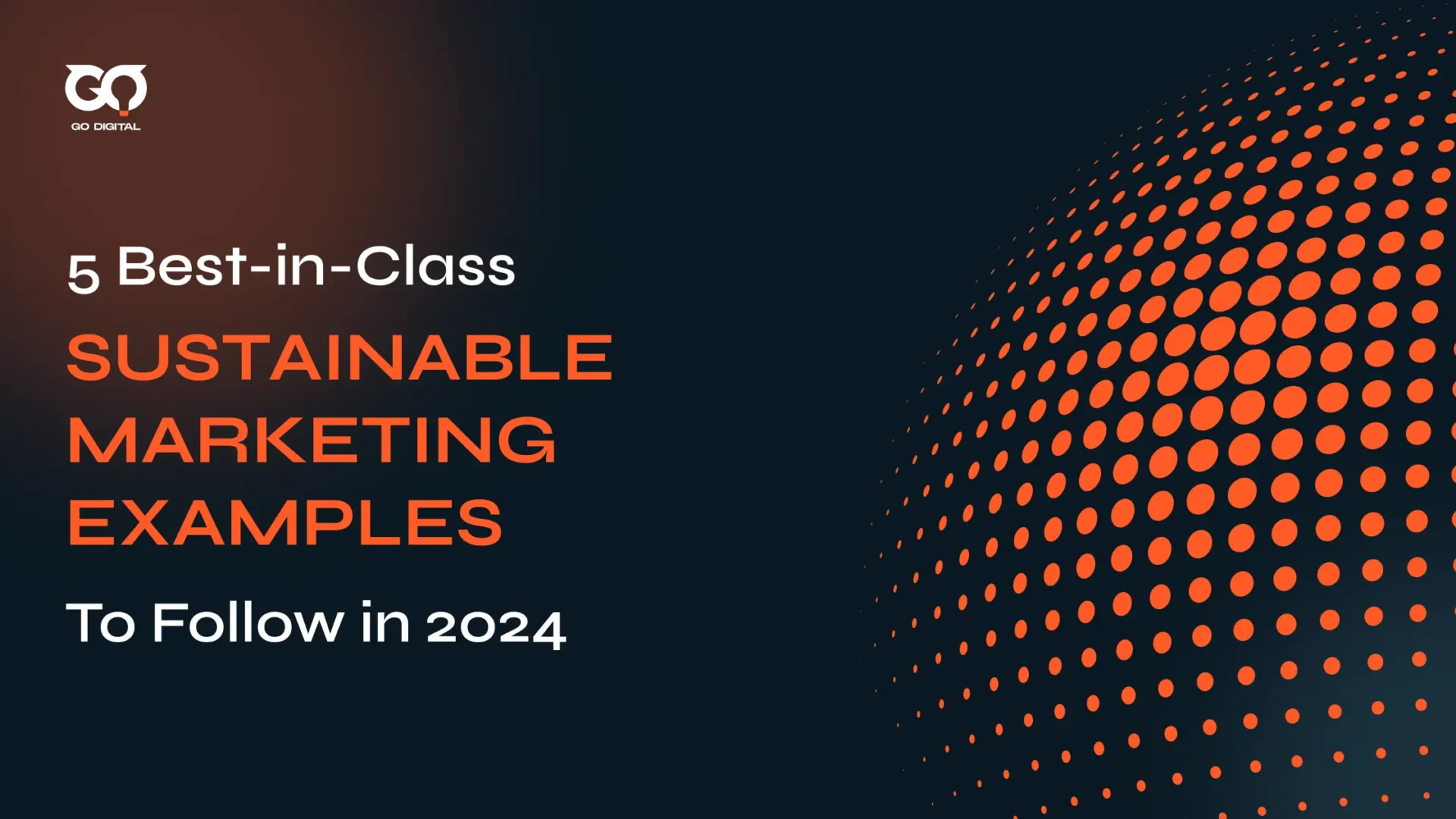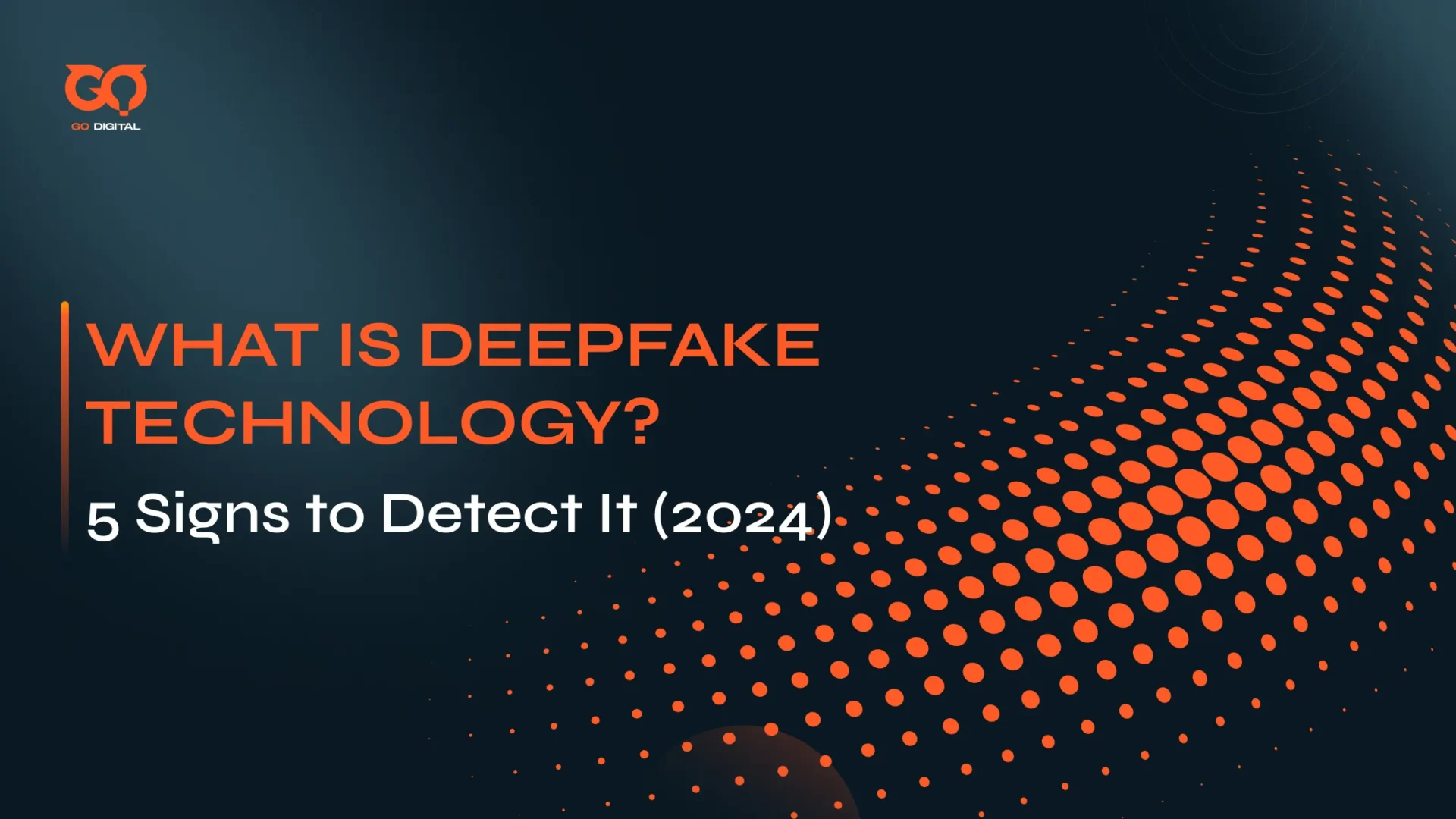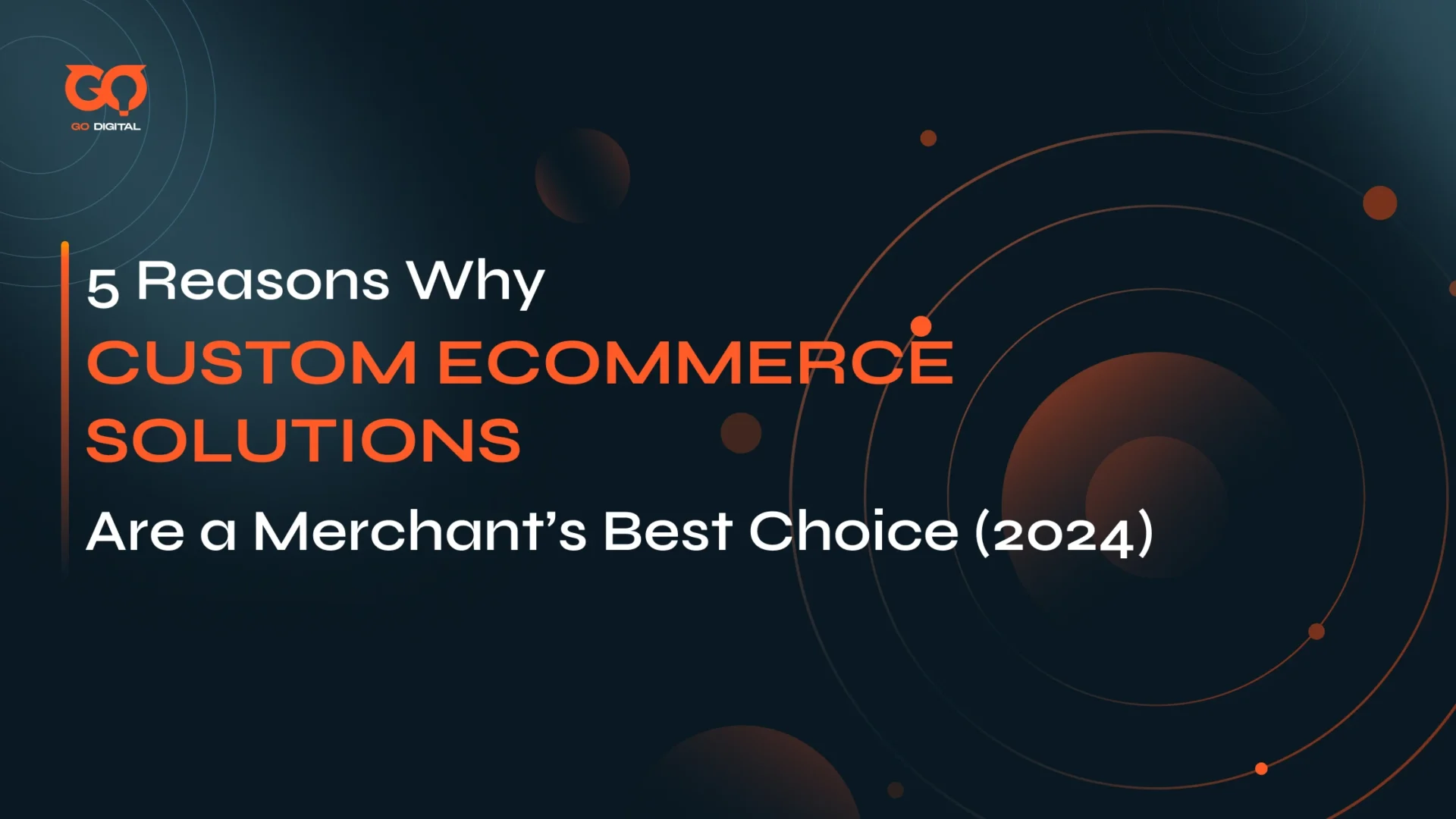Is your marketing strategy aligned with the growing demand for sustainability?
73% of business-to-business buyers are willing to pay more to companies with a strong purpose, compared to 48% of consumers. As consumers become more eco-aware, businesses that overlook sustainable practices may find themselves falling behind.
In 2024, especially, sustainable marketing has become an essential practice for B2B companies worldwide. Brands that prioritize eco-friendly approaches are gaining long-term customer loyalty and positioning themselves as industry leaders.
In this article, we will explore how sustainability is reshaping marketing strategies and offer five real-world sustainable marketing examples of brands leading the way in 2024.
What is Sustainable Marketing?
Sustainable marketing is a type of marketing that focuses on the environmental and social impact of a company’s products or services and practices as an integral part of its marketing strategy.
This approach can include highlighting sustainability initiatives related to specific products or services offered, causes supported, or core brand values.
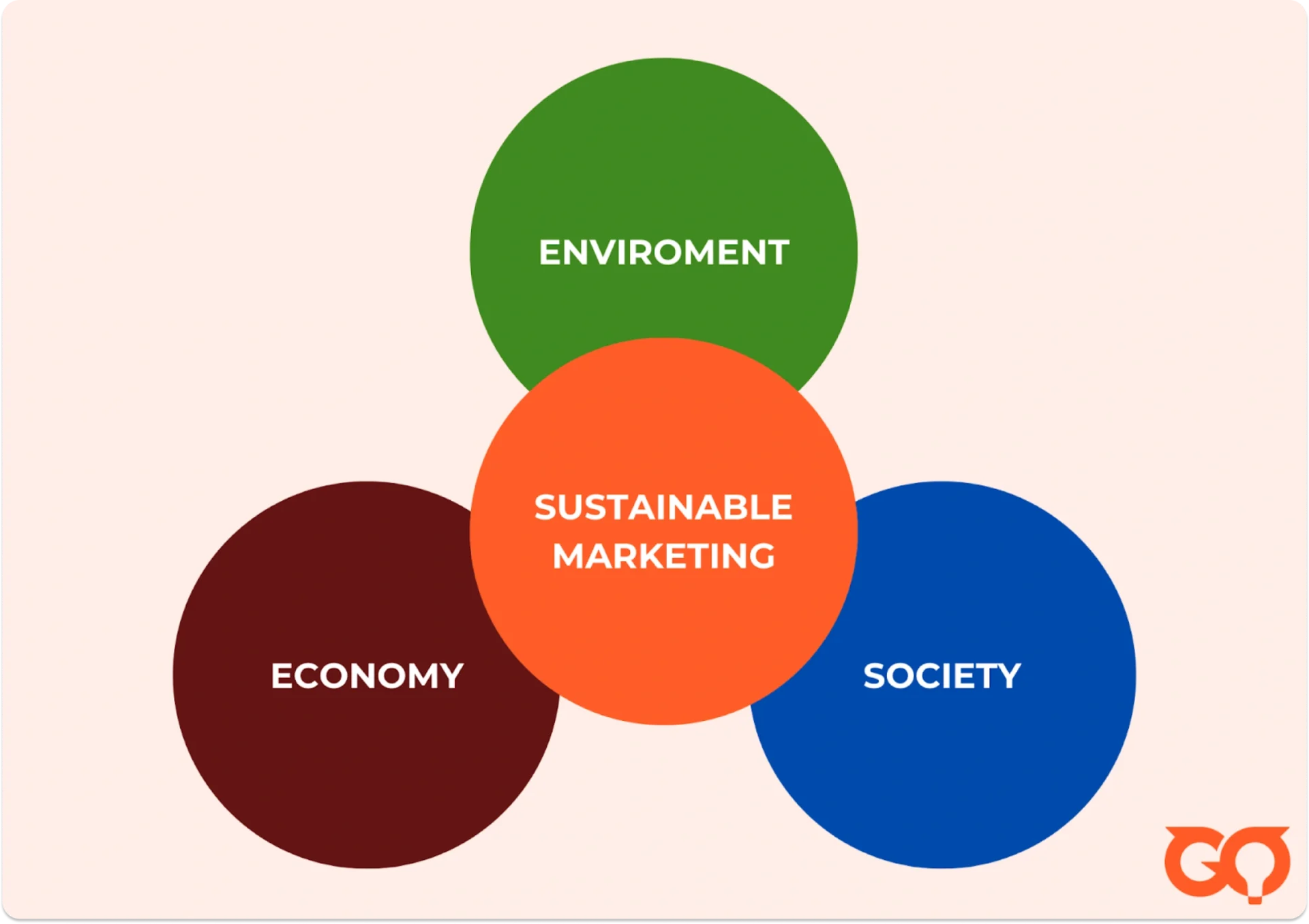
Sustainable marketing aims to create lasting value and reduce harm to the planet. This helps build a more responsible and environmentally aware market.
Key Benefits of A Sustainable Marketing Campaign
Did you know 39.2% of European companies now dedicate more time to sustainable marketing than traditional campaigns? Adopting sustainable marketing offers a wide range of benefits for businesses, especially in emerging markets. Here’s a quick breakdown of the key advantages:
- Enhanced Reputation: Companies prioritizing sustainability build a strong reputation and earn the trust of consumers who value corporate responsibility. This boosts credibility and brand trust.
- Increased Customer Loyalty: Customers are more likely to stick with brands that reflect their own values. Sustainable practices help build stronger, long-lasting customer relationships.
- Competitive Advantage: In a crowded market, eco-friendly initiatives make your brand stand out. Highlighting sustainability attracts customers who prioritize environmental responsibility.
- Cost Savings: Sustainable marketing often involves optimizing resources and reducing waste, leading to lower costs while benefiting the environment.
- Access to New Markets: Businesses that emphasize eco-friendly practices can tap into new markets that care about sustainability, helping them expand their customer base.
- Improved Employee Morale: Focusing on sustainability can enhance ESG (environmental, social, and governance) performance, leading to higher employee loyalty, productivity, and satisfaction.
- Positive Environmental Impact: Sustainable marketing helps protect the environment, fight climate change, and create a healthier planet for future generations—a cause that resonates with both consumers and stakeholders.
- Long-Term Profitability: By embracing sustainability, companies can create business models that ensure long-term success, while also meeting societal needs.
Incorporating these principles into your marketing strategy is more than just a trend—it’s a smart move for long-term growth.
What Are The Most Common Challenges in Sustainable Marketing?
Sustainable brands are leading the charge for a greener future but face challenges. Marketing goes beyond sales—it’s about inspiring consumers to invest in sustainability. These brands need to secure funding, educate the public, and find a way to keep prices affordable while staying true to their ethical commitments.
Let’s dive into the key challenges and strategies that help them thrive.
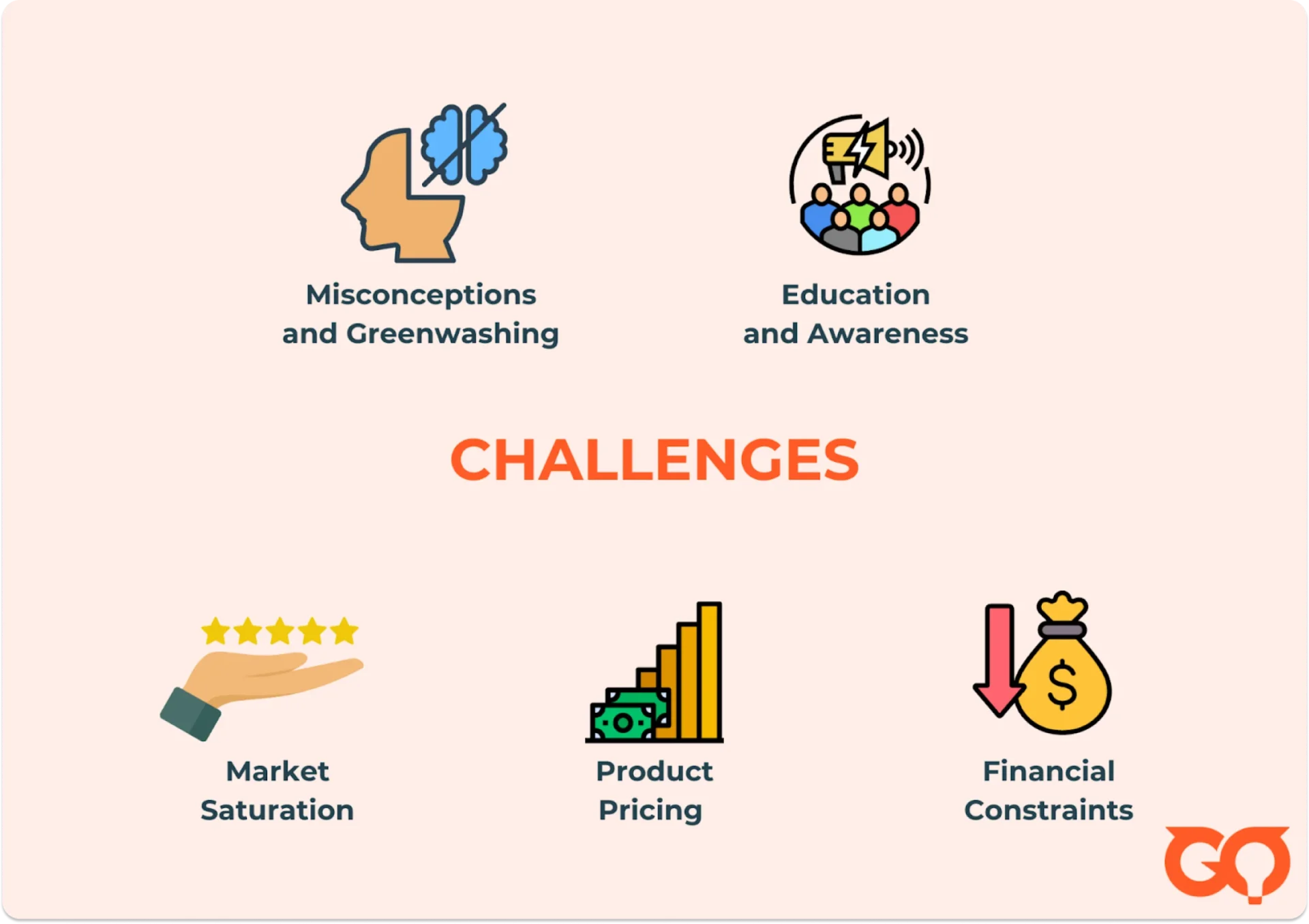
Financial Constraints
Establishing a sustainable brand involves considerable financial hurdles. The initial investment can be high, and the pressure to achieve profitability quickly is significant.
Solution: Brands can get creative by securing donations or using upcycled materials to ease financial strain.
Product Pricing
Sustainable brands face challenges in pricing their products in a highly competitive market. They must also maintain ethical and eco-friendly practices. Sustainable production often incurs higher costs due to the use of eco-friendly materials. And this leads to higher retail prices.
Solution: Be transparent about the costs of eco-friendly production. Educating customers on why sustainable products are worth the investment can help justify the price.
Education and Awareness
Not everyone understands the importance of sustainability, making it a challenge to both market and educate at the same time.
Solution: Use social media and influencers to spread awareness. This approach helps inform consumers while also promoting the brand.
Misconceptions and Greenwashing
Consumers are becoming more skeptical due to greenwashing—when brands falsely claim to be sustainable.
Solution: Authenticity is crucial; brands that transparently communicate their genuine sustainability efforts. Providing verifiable information and engaging in community initiatives can help combat skepticism.
Market Saturation
As the sustainable market expands, differentiation becomes challenging. With brands like Everlane and Reformation leading the charge, simply being “sustainable” is no longer enough.
Solution: Focus on storytelling and emotional branding to connect with consumers on a deeper level. Leveraging tech like AI, AR, or VR can also create unique experiences that make a brand stand out.
5 Sustainable Marketing Examples To Follow (2024)
1. Burt’s Bees
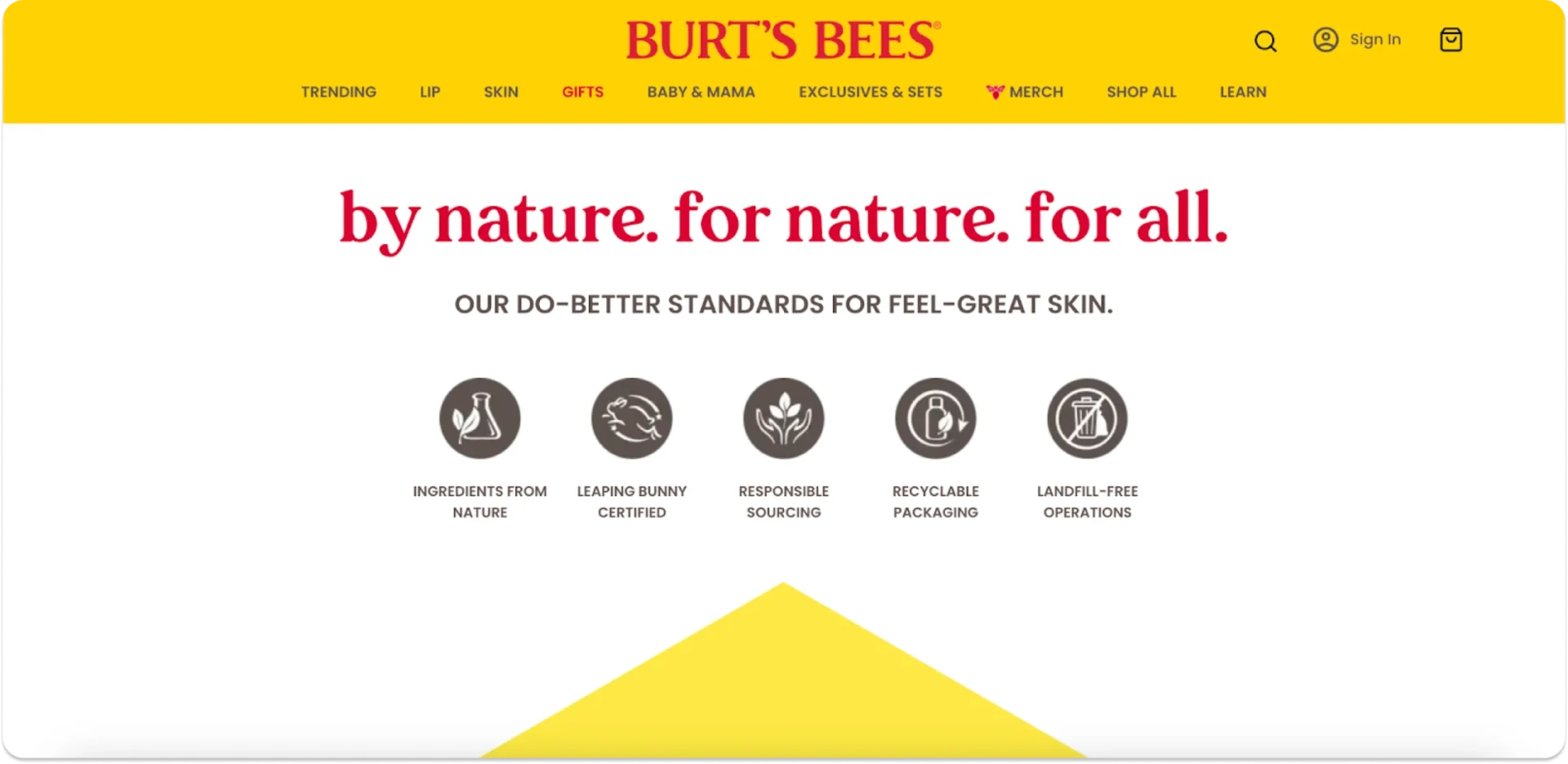
Burt’s Bees is known for offering eco-friendly beauty products like lip balms and lotions, all created with sustainability in mind. The brand puts a strong focus on being transparent and accountable, ensuring their practices positively impact both people and the planet. Their key principles include:
- Using natural, non-synthetic ingredients
- No animal testing
- Responsibly sourcing materials
- Using recycled packaging
- Maintaining landfill-free operations
Why this is a great example:
Burt’s Bees shows that sustainability can be at the core of a beauty brand without sacrificing product quality. They’ve earned trust by being open about their practices and sticking to ethical principles, which helps them stand out in a competitive market.
2. Apple
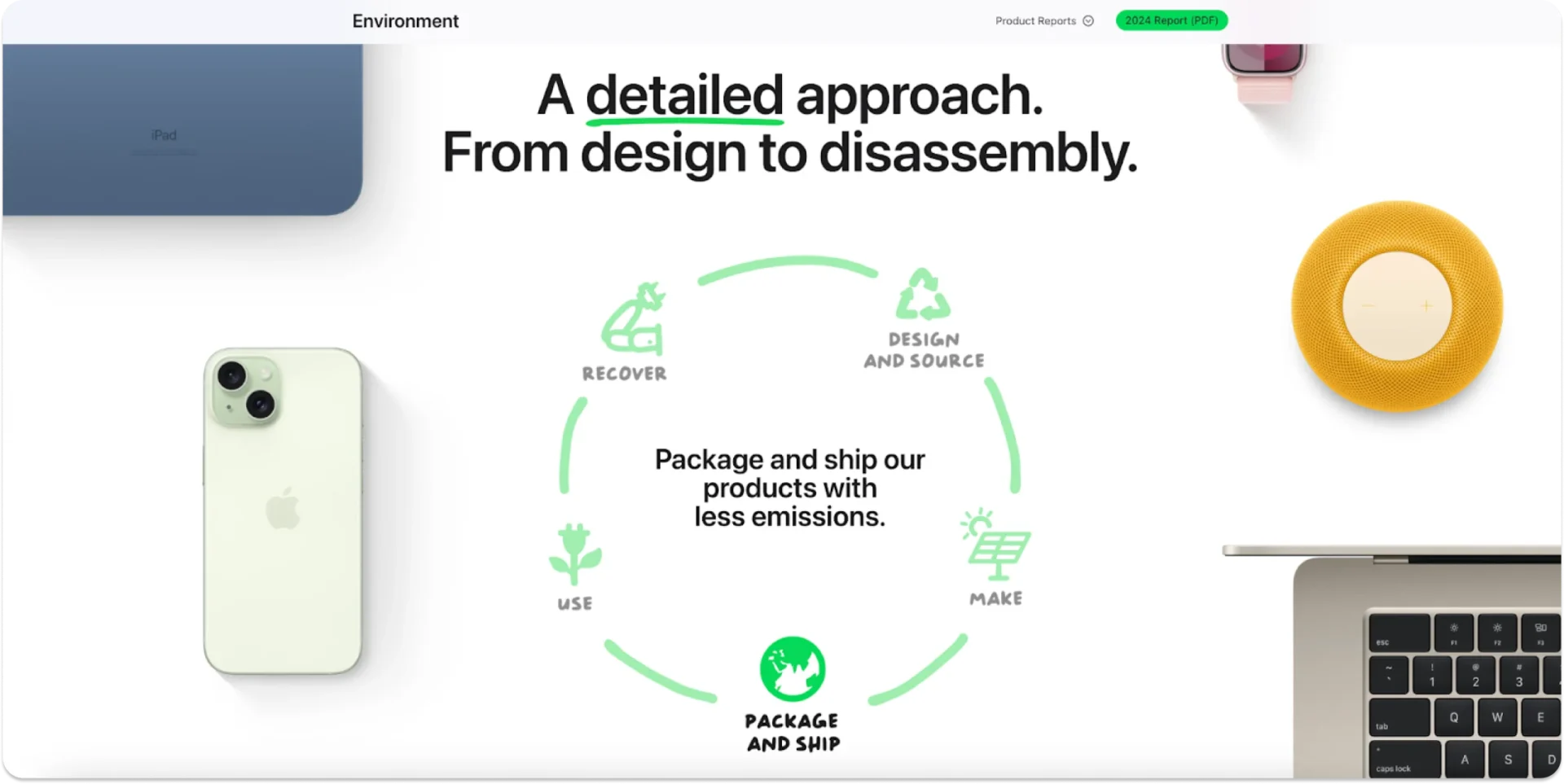
Apple’s logo, one of the world’s most recognizable symbols, resonates with our minds. Through their website, they use powerful visuals to highlight how nature and environmental responsibility are central to their products. This creates a meaningful connection between the brand and eco-conscious values.
Previously, Apple’s messaging leaned into activism with phrases like “fight” and “every voice matters,” appealing to social justice causes. Today, they’ve shifted to a tone of collaboration and progress, calling for collective action. This more inclusive message feels authentic, inviting consumers to actively participate in their sustainability journey by choosing Apple’s products.
Why this is a great example:
Apple’s ability to weave sustainability into its iconic brand story makes it feel authentic. Their messaging invites customers to be part of a larger movement, proving that a tech giant can lead the way in eco-responsibility while still promoting high-end products.
3. Lego
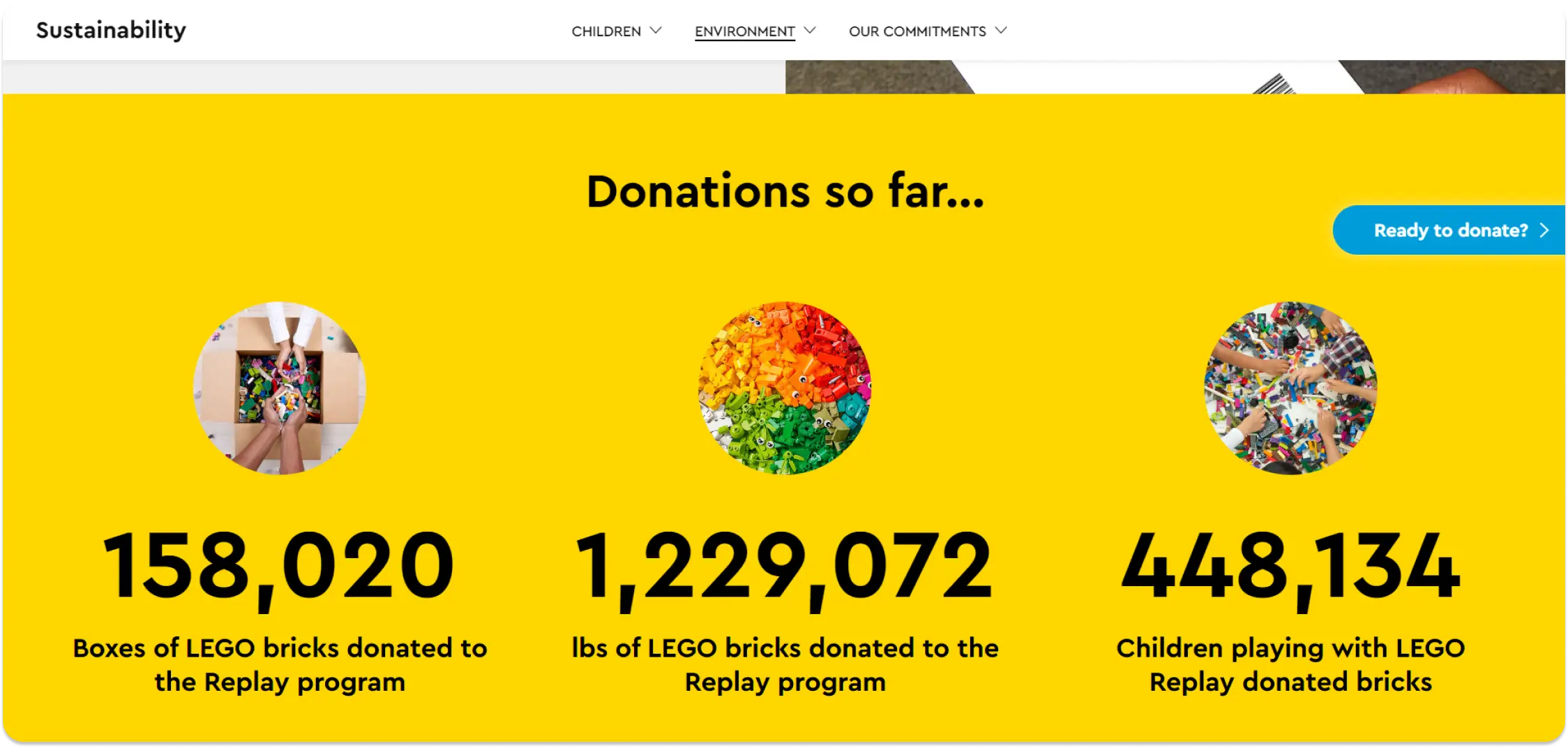
LEGO has committed to making its products and operations more sustainable. They’re working toward using only sustainable materials for their toy blocks by 2030 and have a range of initiatives:
- Using recycled and bioplastic materials
- Switching to renewable or recycled packaging
- Running operations on 100% CO2-neutral energy from wind farms
- Partnering with WWF to cut emissions
- Launching LEGO Replay to encourage donating used bricks
- Planting trees to offset deforestation from new factories
Why this is a great example:
LEGO’s commitment to sustainability is both ambitious and impactful. Through clear objectives and partnerships with groups like WWF, LEGO is working to reduce its environmental impact while motivating its customers, particularly young people, to think and act in eco-friendly ways.
4. Patagonia

Patagonia is at the forefront of tackling climate change and finding sustainable solutions for its products. While they acknowledge that not all their products are fully sustainable (some are still made with fossil fuels), Patagonia’s strong commitment to environmental causes keeps their reputation intact. Their strategy includes:
- Donating millions to environmental initiatives like sustainable agriculture and rainforest restoration
- Encouraging customers to buy less and recycle/repair gear
- Running the Patagonia Action Works platform to connect people with grassroots environmental efforts
Why this is a great example:
Patagonia’s authenticity sets it apart. They’re honest about their imperfections while still leading meaningful environmental efforts. Their campaigns challenge traditional consumerism and push for broader cultural change toward sustainability.
5. Lacoste
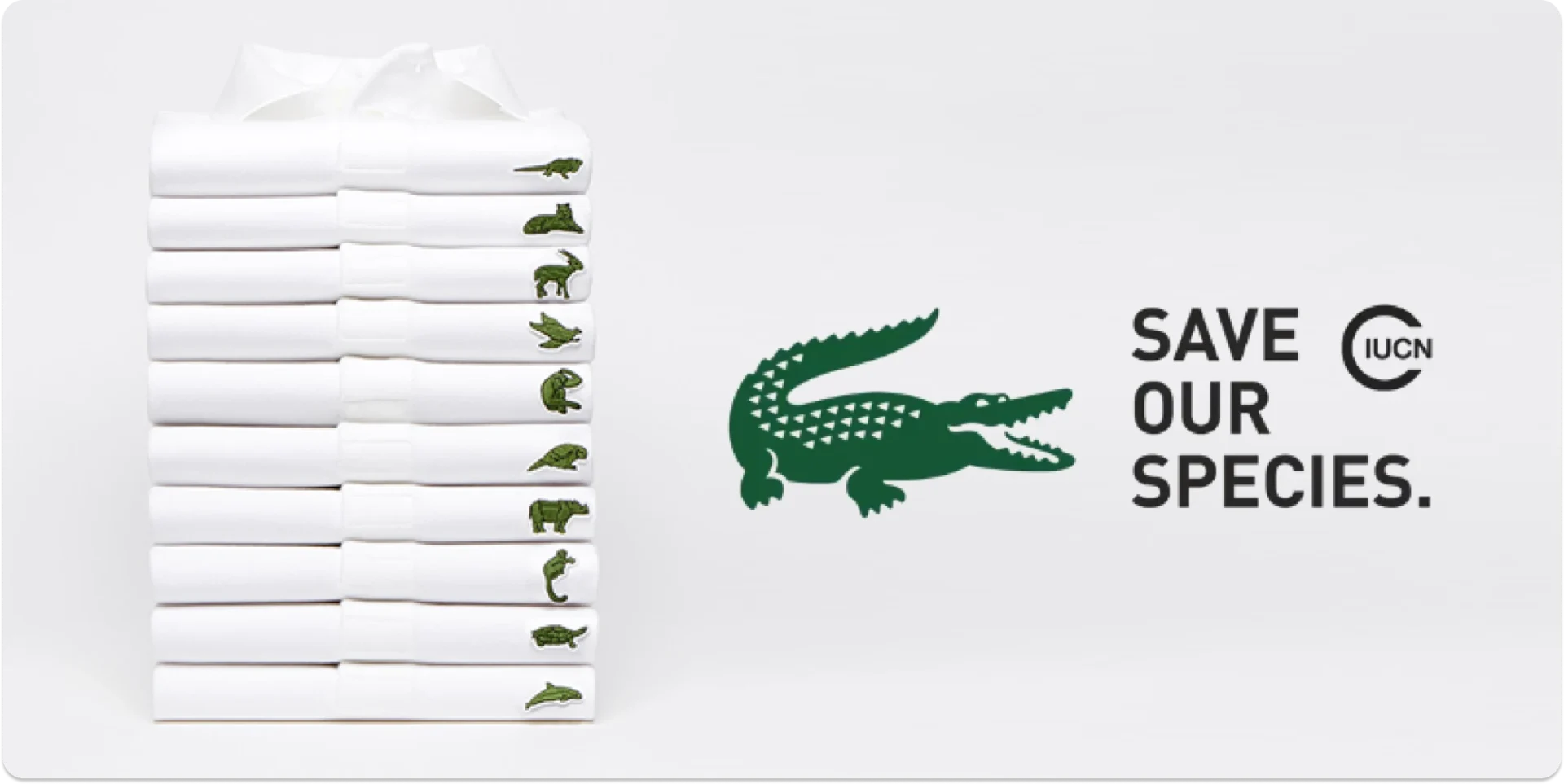
Lacoste took a unique approach by reworking its iconic crocodile logo as part of its sustainability campaign. Instead of hiding their sustainability efforts, Lacoste highlighted endangered species through limited-edition polo shirts. These shirts replaced the crocodile logo with one of ten critically endangered animals, raising awareness for both wildlife conservation and environmental responsibility.
Why this is a great example:
Lacoste proves that creativity in sustainable marketing can have a big impact. By using their famous logo to highlight endangered species, they brought sustainability to the forefront in a visually striking and memorable way that resonated with consumers.
What is Green Marketing?
Green marketing refers to the promotion of environmentally friendly products or services. It highlights sustainability as a core aspect of these offerings.
This marketing approach emphasizes the benefits of eco-friendly products. It aims to appeal to consumers who are concerned about their environmental impact. Here are some key aspects of green marketing:
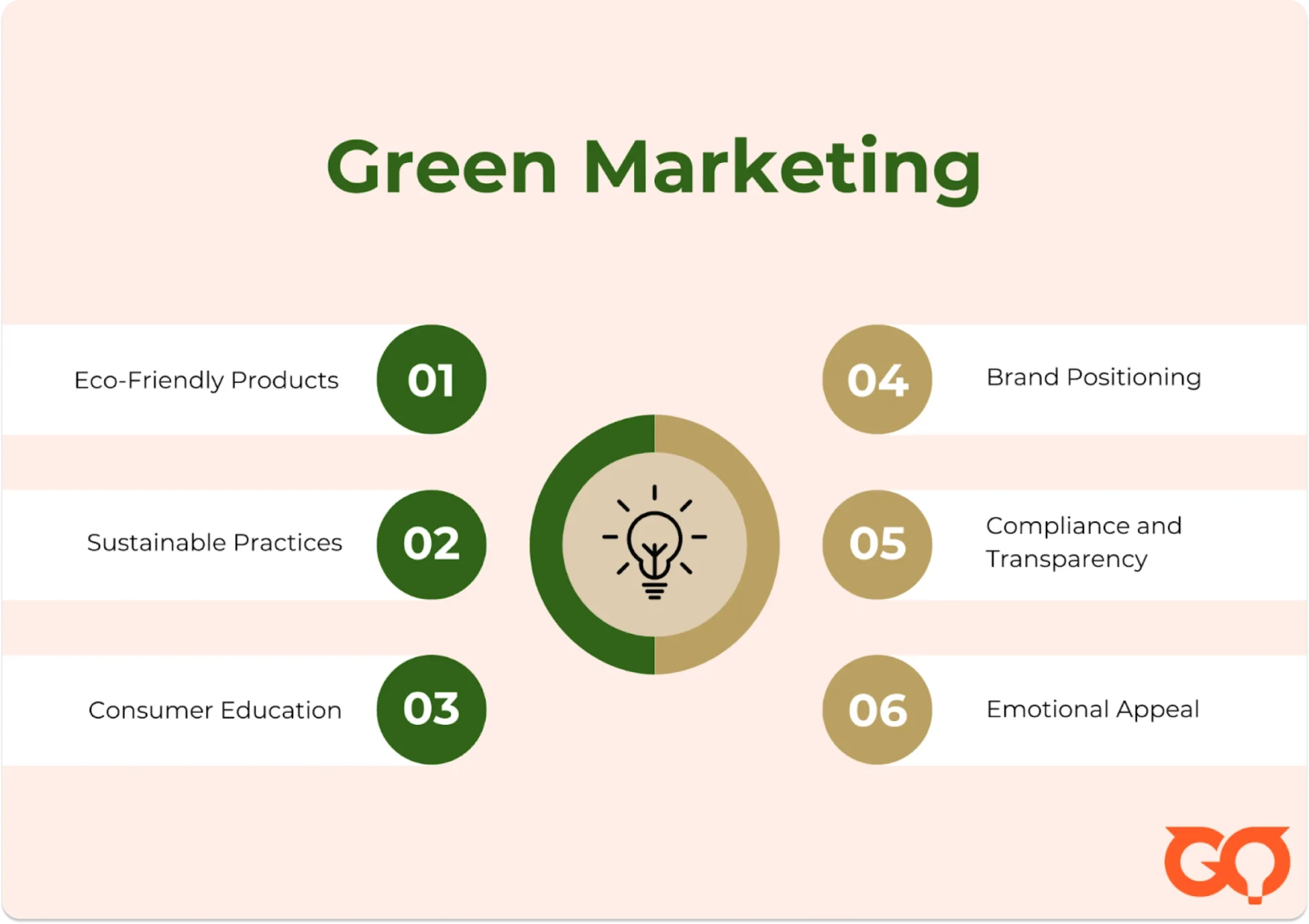
- Eco-Friendly Products: Green marketing emphasizes products made from sustainable materials, energy-efficient processes, and minimal environmental impact. Think biodegradable packaging, organic ingredients, and renewable resources.
- Sustainable Practices: Companies that embrace green marketing often showcase their sustainable practices. This includes reducing waste, conserving energy, and sourcing materials responsibly. Such efforts can improve a company’s reputation and draw in eco-conscious customers.
- Consumer Education: A big part of green marketing is educating consumers about the environmental benefits of products. This includes explaining how a product can lower carbon emissions, save resources, or protect wildlife.
- Brand Positioning: Many businesses use green marketing to stand out from the competition. Positioning themselves as eco-friendly can attract consumers who prioritize sustainability.
- Compliance and Transparency: Green marketing emphasizes following environmental regulations and being transparent about business practices. Companies that openly share their sustainability efforts can build trust with consumers.
- Emotional Appeal: Green marketing appeals to consumers’ emotions by tapping into their desire to make responsible choices. This can lead to greater brand loyalty and customer engagement.
In summary, green marketing aims to promote environmentally responsible products and practices. Thereby aligning business objectives with the values of eco-conscious consumers. As sustainability becomes more important in the marketplace, green marketing is gaining recognition. It is now seen as a key strategy for businesses looking to thrive.
| 💡Fun Fact: One ton of 100% recycled paper saves the equivalent of 4,100 kWh of energy, 7,000 gallons of water, 60 pounds of air emissions, and three cubic yards of landfill space! |
The Difference Between Sustainable Marketing and Green Marketing
Sustainable marketing takes a holistic view of how a product is created, used, and disposed of. It looks at the overall impact on the environment, society, and future generations, focusing on the long-term viability of resources and ecosystems.
On the other hand, green marketing primarily highlights a product’s eco-friendly features. While it promotes these attributes, it doesn’t necessarily address broader sustainability concerns. For example, a product might be labeled as “green” because of its environmentally friendly features, but it could still contribute to resource depletion or social issues, meaning it’s not truly sustainable.
Sustainable marketing is important because it bridges the gap between these two concepts. It communicates a brand’s commitment to minimizing environmental impact while promoting social responsibility and ethical practices. This approach builds transparency and engages consumers in working toward a more sustainable future.
In short, while green marketing focuses on eco-friendly attributes, sustainable marketing takes a broader perspective, aiming for a positive impact that goes beyond just environmental issues.
Sustainable Marketing as the Blueprint for ESG Success
At Golden Owl Digital, we see sustainable marketing as essential for driving successful ESG (Environmental, Social, and Governance) initiatives. By integrating sustainability into our clients’ marketing practices, we help them resonate with consumers who increasingly prioritize responsible business practices.
Our sustainable marketing strategies provide a clear framework for addressing the complexities of ESG adoption. By setting defined goals and measurable outcomes, we make it easier for businesses to transition toward a more responsible and sustainable model.
We recognize that every client is unique, no matter their industry or niche. Our thorough research and analysis allow us to craft customized strategies that enhance competitiveness while aligning with each brand’s values.
Sustainable marketing goes beyond mere promotion; it’s about making a meaningful impact. Our approach empowers brands to communicate their sustainability efforts authentically and engage consumers in genuine conversations.
Ready to take your sustainable marketing efforts to the next level? Contact us today to learn how Golden Owl Digital can help your brand succeed in its ESG initiatives. Together, we can create marketing strategies that not only elevate your brand but also make a positive difference in the world.
Bottom Line
In summary, sustainable marketing is not just a trend. It is a strategic approach that lays the groundwork for effective ESG practices. By prioritizing sustainability in marketing, businesses can achieve their goals while contributing positively to society and the environment. Start integrating sustainable marketing strategies today to elevate your brand and make a meaningful impact on the world!
FAQs
Q1. What are the 4 P’s of sustainable marketing?
The 4 P’s of sustainable marketing are:
- Product: Designing eco-friendly products using sustainable material.
- Price: Setting prices that reflect the true cost of sustainability without alienating customers.
- Place: Distributing products focus on reducing the carbon footprint. Such as using local sourcing or eco-friendly transportation.
- Promotion: Communicating sustainable values through honest and transparent marketing.
Q2. What would be an example of sustainability?
An example of sustainability is the practice of using renewable resources and minimizing waste to nature. This can include efforts like recycling, utilizing energy-efficient processes, and sourcing materials responsibly to reduce environmental impact. This commitment not only promotes eco-friendly practices but also supports conservation efforts globally.


